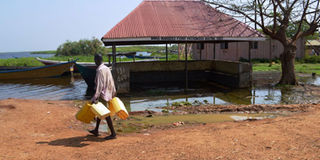How human activities are killing Lake Albert

The submerged ferry waiting shed at Wanseko Landing Site in Buliisa District on February 12, 2020. PHOTO BY ANDREW MUGATI
What you need to know:
- The Ntoroko District environment officer, Mr Herbert Kamuhanda, says the problem started upstream on River Semuliki in Bundibugyo where Kirumya, Humya, Tokwe, Nyaruru, Rugo, Ngite, Nyahuka, Sundira, Ndugutu and Lamia rivers burst their banks due to running water from the bare mountain slopes.
Uncontrolled human activities around River Semuliki in Bundibugyo and Ntoroko districts have led to rising water levels on Lake Albert, thereby paralysing business in downstream Buliisa District, Daily Monitor has established.
River Semuliki emanates from Lake Edward with its main catchment in the Rwenzori Mountains on the side of Bundibugyo.
River Semuliki snakes through Bundibugyo and Ntoroko districts where uncontrolled human activities such as deforestation and soil erosion have caused sedimentation in the river that empties into Lake Albert.
As a result, Buliisa District has since January been experiencing rising water levels on River Nile and Lake Albert, which have disrupted fishing and other activities on landing sites in the area.
The most affected are landing sites in Kigwera, Buliisa and Butiaba sub-counties, and Buliisa Town Council. To access some of the landing sites, people now use canoes. The fish slab, ferry waiting shed and some houses at Wanseko and Butyaba landing sites in Buliisa have been submerged.
Mr Bagadira William, a captain of a boat that plies Wanseko-Panyimur transport route, says due to rising water levels, water weed is floating on both Upper Nile and Lake Albert thereby blocking the landing sites on the Nile.
“Rising water levels have set water hyacinth loose. Our path to Panyimur has been blocked, forcing us to shift from our previous landing sites on River Nile to Lake Albert where there is a lot of wind that hits our boats. We are nearing March and we expect more winds and our boats are not secure here,” Mr Bagadira says.
Mr Didasco Mwesigwa, a fisherman, says: “Rising water levels have scared fish away from the water near the shore. Fish has moved to deeper waters of the lake”.
Uncontrolled activities
Buliisa District Environment Officer Rogers Tumusiime attributes the rising water levels to human activities in swamps and on the lake shores.
“We are experiencing flooding or rising water levels due to human activities such as sand mining, degrading swamps and cutting/clearing papyrus, which used to retain the excess water,” he says.
Mr Tumusiime urges the people not to interfere with the ecological system and the buffer zones on rivers. “We should respect the buffer zones of 30-100 meters on the rivers and stop cultivating close to the rivers. What is happening on the lake now may happen in upper Buliisa,” he says. Mr Tumusiime adds that they will soon evict all wetland encroachers.
“There is a presidential directive that everyone cultivating in the buffer zones and swamps should not plant for the next season. Continuous cultivation along these areas may push us to enforce the directive,” he warns.
Mr Jeconious Musingwire, the south western regional officer for the National Environment Management Authority (Nema), attributes the rising water levels on Lake Albert to recent floods in the area.
“There were flash floods in Bundibugyo in December and the subsequent rains in January. All these have been flowing through a lose catchment of River Semuliki that empties into Lake Albert,” he says.
Mr Musingwire adds: “This big water volume comes with sediments to the landing sites in Buliisa. Sediments raise the lake bed due to poor management of the river catchment. That is why in most times, water in River Semuliki turns brown in colour.”
The Ntoroko District environment officer, Mr Herbert Kamuhanda, says the problem started upstream on River Semuliki in Bundibugyo where Kirumya, Humya, Tokwe, Nyaruru, Rugo, Ngite, Nyahuka, Sundira, Ndugutu and Lamia rivers burst their banks due to running water from the bare mountain slopes.
“Poor human activities on the slopes of Bundibugyo District and population pressure are responsible for the floods,” Mr Kamuhanda says.




